Comparative Thermo-Mechanical Properties of Sustainable Epoxy Polymer Networks Derived from Linseed Oil
Abstract
1. Introduction
2. Materials and Methods
2.1. Materials
2.2. Chemical Functionalization of the LO
2.3. Synthesis of the ELO-Based Polymeric Matrices
2.4. Characterization Techniques
3. Results and Discussion
3.1. ELO Synthesis and Structural Characterization
3.2. DSC Studies for the ELO-Based Initial Formulation
3.3. FTIR Spectrometry Studies
3.4. The Curing Kinetics for the Formulated ELO-Based Systems
3.5. Thermal Stability
3.6. Dynamic-Mechanical Analysis
3.7. Nanoindentation
3.8. Mechanical Test
3.9. Degradation Studies
3.10. Wettability Assessment
4. Conclusions
Supplementary Materials
Author Contributions
Funding
Data Availability Statement
Conflicts of Interest
References
- Manawwer, A.; Deewan, A.; Eram, S.; Fahmina, Z.; Sharif, A. Vegetable oil based eco-friendly coating materials: A review article. Arab. J. Chem. 2021, 7, 469–479. [Google Scholar] [CrossRef]
- Miao, S.; Wang, P.; Su, Z.; Zhang, S. Vegetable-oil-based polymers as future polymeric biomaterials. Acta Biomater. 2014, 10, 1692–1704. [Google Scholar] [CrossRef]
- Vevere, L.; Fridrihsone, A.; Kirpluks, M.; Cabulis, U. A Review of Wood Biomass-Based Fatty Acids and Rosin Acids Use in Polymeric Materials. Polymers 2020, 12, 2706. [Google Scholar] [CrossRef]
- Adhvaryu, A.; Erhan, S.Z. Epoxidized soybean oil as a potential source of high-temperature lubricants. Ind. Crops Prod. 2002, 15, 247–254. [Google Scholar] [CrossRef]
- Haryono, A.; Triwulandari, E.; Jiang, P. Interaction between vegetable oil based plasticizer molecules and polyvinyl chloride, and their plasticization effect. AIP Conf. Proc. 2017, 1803, 020045. [Google Scholar] [CrossRef]
- Jebrane, M.; Cai, S.; Sandström, C.; Terziev, N. The reactivity of linseed and soybean oil with different epoxidation degree towards vinyl acetate and impact of the resulting copolymer on the wood durability. Express Polym. Lett. 2017, 11, 383–395. [Google Scholar] [CrossRef]
- Sharma, B.K.; Adhvaryu, A.; Liu, Z.; Erhan, S.Z. Chemical modification of vegetable oils for lubricant applications. J. Am. Oil Chem. Soc. 2006, 83, 129–136. [Google Scholar] [CrossRef]
- Woma, T.Y.; Lawal, S.A.; Abdulrahman, A.S.; Olutoye, M.A.; Ojapah, M.M. Vegetable Oil Based Lubricants: Challenges and Prospects. J. Tribol 2019, 14, 60–70. [Google Scholar] [CrossRef]
- Lewinska, A.; Zebrowski, J.; Duda, M.; Gorka, A.; Wnuk, M. Fatty Acid Profile and Biological Activities of Linseed and Rapeseed Oils. Molecules 2015, 20, 22872–22880. [Google Scholar] [CrossRef]
- Turco, R.; Tesser, R.; Russo, V.; Cogliano, T.; Di Serio, M.; Santacesaria, E. Epoxidation of Linseed Oil by Performic Acid Produced In Situ. Ind. Eng. Chem. Res. 2021, 60, 16607–16618. [Google Scholar]
- Conti Silva, J.A.; Moreira Grilo, L.; Gandini, A.; Martins Lacerda, T. The Prospering of Macromolecular Materials Based on Plant Oils within the Blooming Field of Polymers from Renewable Resources. Polymers 2021, 13, 1722. [Google Scholar] [CrossRef]
- Samper, M.; Ferri, J.; Carbonell, A.; Balart, R.; Gimeno, O. Properties of biobased epoxy resins from epoxidized linseed oil (ELO) crosslinked with a mixture of cyclic anhydride and maleinized linseed oil. Express Polym. Lett. 2019, 13, 407–418. [Google Scholar] [CrossRef]
- Balanuca, B.; Ghebaur, A.; Stan, R.; Vuluga, D.M.; Vasile, E.; Iovu, H. New hybrid materials based on double-functionalized linseed oil and halloysite. Polym. Adv. Technol. 2018, 29, 1744–1752. [Google Scholar] [CrossRef]
- Balanuca, B.; Stan, R.; Lungu, A.; Vasile, E.; Iovu, H. Hybrid networks based on epoxidized camelina oil. Des. Monomers Polym. 2017, 20, 10–17. [Google Scholar] [CrossRef][Green Version]
- Balanuca, B.; Stan, R.; Hanganu, A.; Iovu, H. Novel linseed oil-based monomers: Synthesis and characterization. UPB Sci. Bull. B Chem Mater. Sci. 2014, 76, 129–140. [Google Scholar]
- Balanuca, B.; Lungu, A.; Hanganu, A.; Stan, L.R.; Vasile, E.; Iovu, H. Hybrid nanocomposites based on POSS and networks of methacrylated camelina oil and various PEG derivatives. Eur. J. Lipid Sci. Technol. 2014, 116, 458–469. [Google Scholar] [CrossRef]
- Saithai, P.; Lecomte, J.; Dubreucq, E.; Tanrattanakul, V. Effects of different epoxidation methods of soybean oil on the characteristics of acrylated epoxidized soybean oil-co-poly(methyl methacrylate) copolymer. Express Polym. Lett. 2013, 7, 910–992. [Google Scholar] [CrossRef]
- Ma, S.; Webster, D.C. Naturally Occurring Acids as Cross-Linkers to Yield VOC-Free, High-Performance, Fully Bio-Based, Degradable Thermosets. Macromolecules 2015, 48, 7127–7137. [Google Scholar] [CrossRef]
- Sahoo, S.K.; Khandelwal, V.; Manik, G. Development of completely bio-based epoxy networks derived from epoxidized linseed and castor oil cured with citric acid. Polym. Adv. Technol 2018, 29, 2080–2090. [Google Scholar] [CrossRef]
- Lascano Aimacaña, D.S.; Quiles-Carrillo, L.; Balart, R.; Boronat, T.; Montanes, N. Kinetic Analysis of the Curing of a Partially Biobased Epoxy Resin Using Dynamic Differential Scanning Calorimetry. Polymers 2019, 11, 391. [Google Scholar] [CrossRef]
- Dinu, R.; Mija, A. Bio-based epoxy resins and composites from epoxidized linseed oil crosslinked with different cyclic anhydrides and their combination with lignin. Cellul. Chem. Technol. 2020, 59, 925–938. [Google Scholar] [CrossRef]
- Altuna, F.; Pettarin, V.; Williams, R.J.J. Self-healable polymer networks based on the cross-linking of epoxidised soybean oil by an aqueous citric acid solution. Green Chem. 2013, 15, 3360–3366. [Google Scholar] [CrossRef]
- Ding, C.; Shuttleworth, P.S.; Makin, S.; Clark, J.H.; Matharu, A.S. New insights into the curing of epoxidized linseed oil with dicarboxylic acids. Green Chem. 2015, 17, 4000–4008. [Google Scholar] [CrossRef]
- Corezzi, S.; Fioretto, D.; Santucci, G.; Kenny, J.M. Modeling diffusion-control in the cure kinetics of epoxy-amine thermoset resins: An approach based on configurational entropy. Polymer 2010, 51, 5833–5845. [Google Scholar] [CrossRef]
- Ahmadi, Z. Epoxy in nanotechnology: A short review. Prog. Org. Coat. 2019, 132, 445–448. [Google Scholar] [CrossRef]
- Richaud, E.; Guinault, A.; Baiz, S.; Nizeyimana, F. Epoxidized linseed oils based networks. Case of thermal degradation. Polym. Degrad. Stab. 2019, 166, 121–134. [Google Scholar] [CrossRef]
- Campanella, A.; Zhan, M.; Watt, P.; Grous, A.; Shen, C.; Wool, R. Triglyceride-based Thermosetting Resins with Different Reactive Diluents and Fiber Reinforced Composite Applications. Compos. Part A Appl. Sci. 2015, 72, 192–199. [Google Scholar] [CrossRef]
- Herbert, E.G.; Oliver, W.C.; Pharr, G.M. Nanoindentation and the dynamic characterization of viscoelastic solids. J. Phys. D Appl. Phys. 2008, 41, 074021. [Google Scholar] [CrossRef]
- Olăreț, E.; Bălănucă, B.; Onaș, A.M.; Ghițman, J.; Iovu, H.; Stancu, I.-C.; Serafim, A. Double-Cross-Linked Networks Based on Methacryloyl Mucin. Polymers 2021, 13, 1706. [Google Scholar] [CrossRef]
- Olăreț, E.; Steinmüller-Nethl, D.; Iovu, H.; Stancu, I.C. Nanodiamond loaded fish gelatin enzymatically crosslinked hydrogels. U.P.B. Sci. Bull. Ser. B 2022, 84, 27–40. [Google Scholar]
- Abdus Samad, U.; Alam, A.; Chafidz, A.; Al-Zahrani, S.; Alharthy, N. Enhancing mechanical properties of epoxy/polyaniline coating with addition of ZnO nanoparticles: Nanoindentation characterization. Prog. Org. Coat. 2018, 119, 109–115. [Google Scholar] [CrossRef]
- Kalita, D.J.; Tarnavchyk, I.; Chisholm, B.J.; Webster, D.C. Novel bio-based epoxy resins from eugenol as an alternative to BPA epoxy and high throughput screening of the cured coatings. Polymer 2021, 223, 124191. [Google Scholar] [CrossRef]
- Stefanidis, D.; Jencks, W.P. General base catalysis of ester hydrolysis. J. Am. Chem. Soc. 1993, 115, 6045–6050. [Google Scholar] [CrossRef]
- Wang, S.; Hu, Z.; Shi, J.; Chen, G.; Zhang, Q.; Weng, Z.; Wu, K.; Lu, M. Green synthesis of graphene with the assistance of modified lignin and its application in anticorrosive waterborne epoxy coatings. Appl. Surf. Sci. 2019, 484, 759–770. [Google Scholar] [CrossRef]
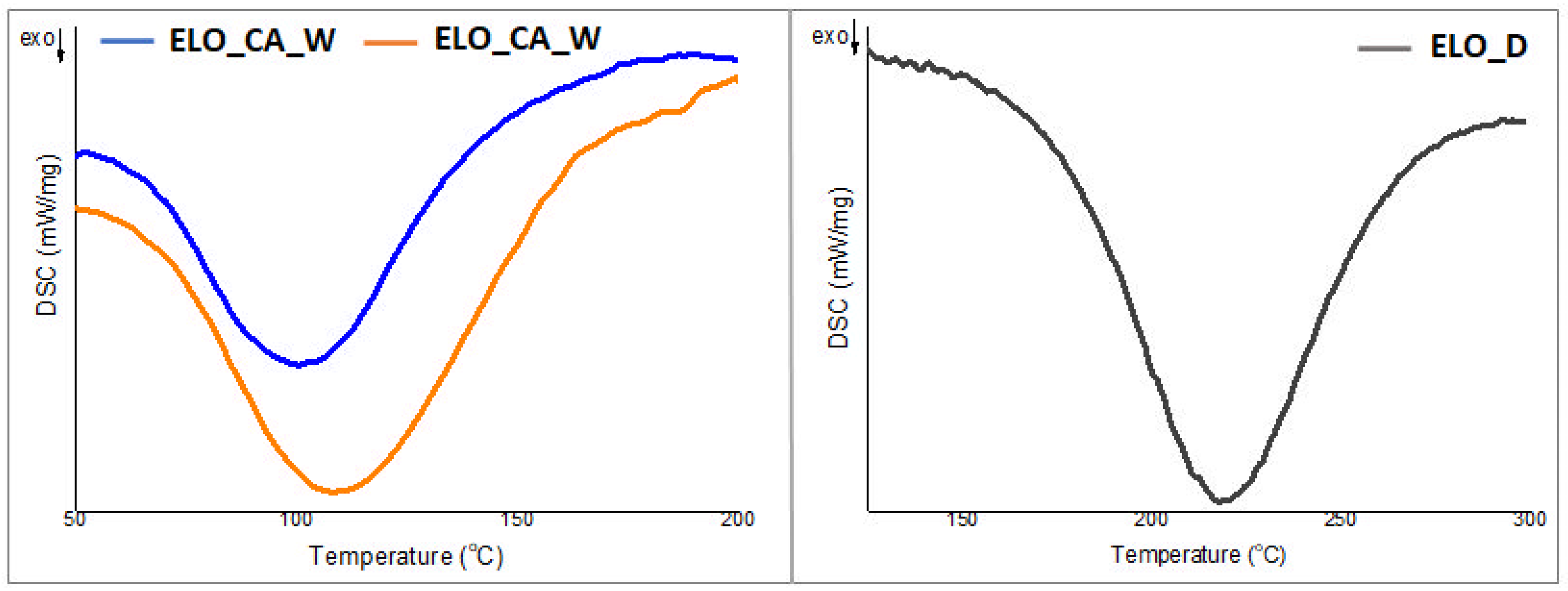

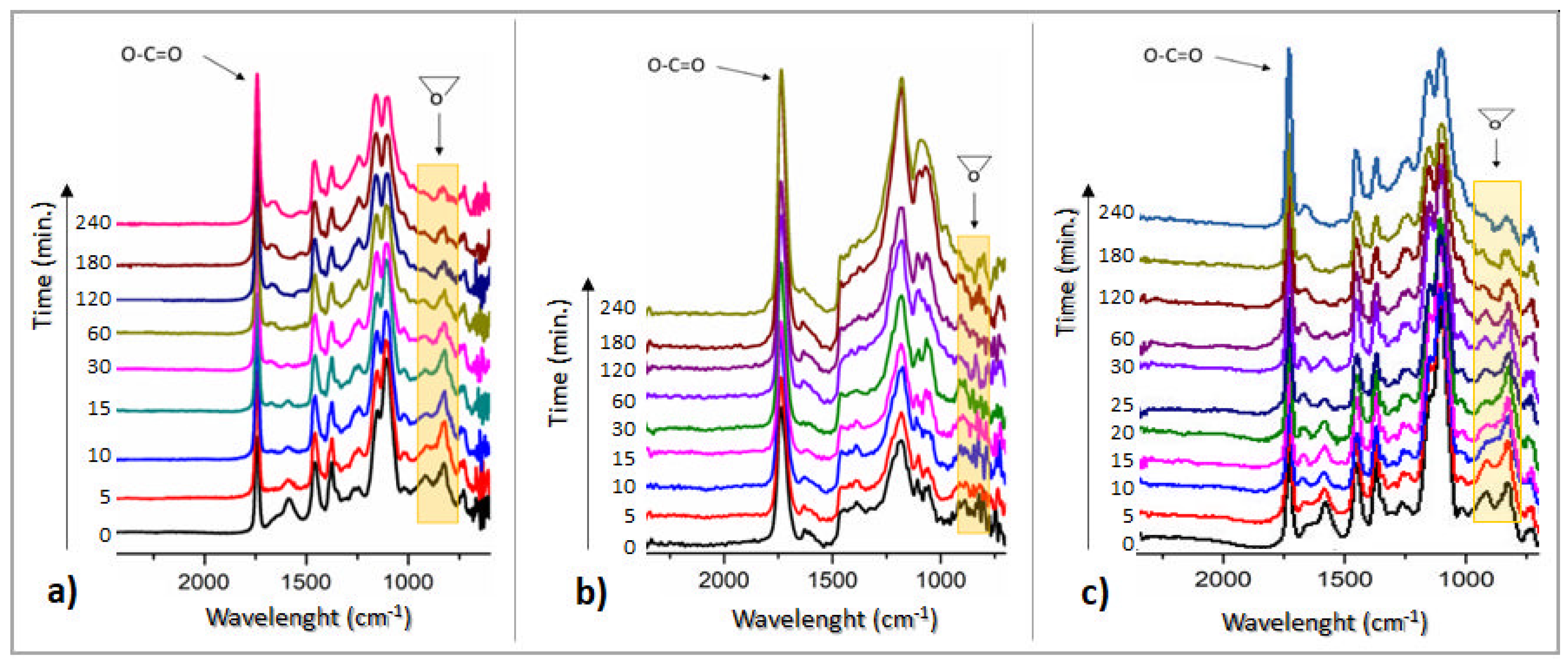
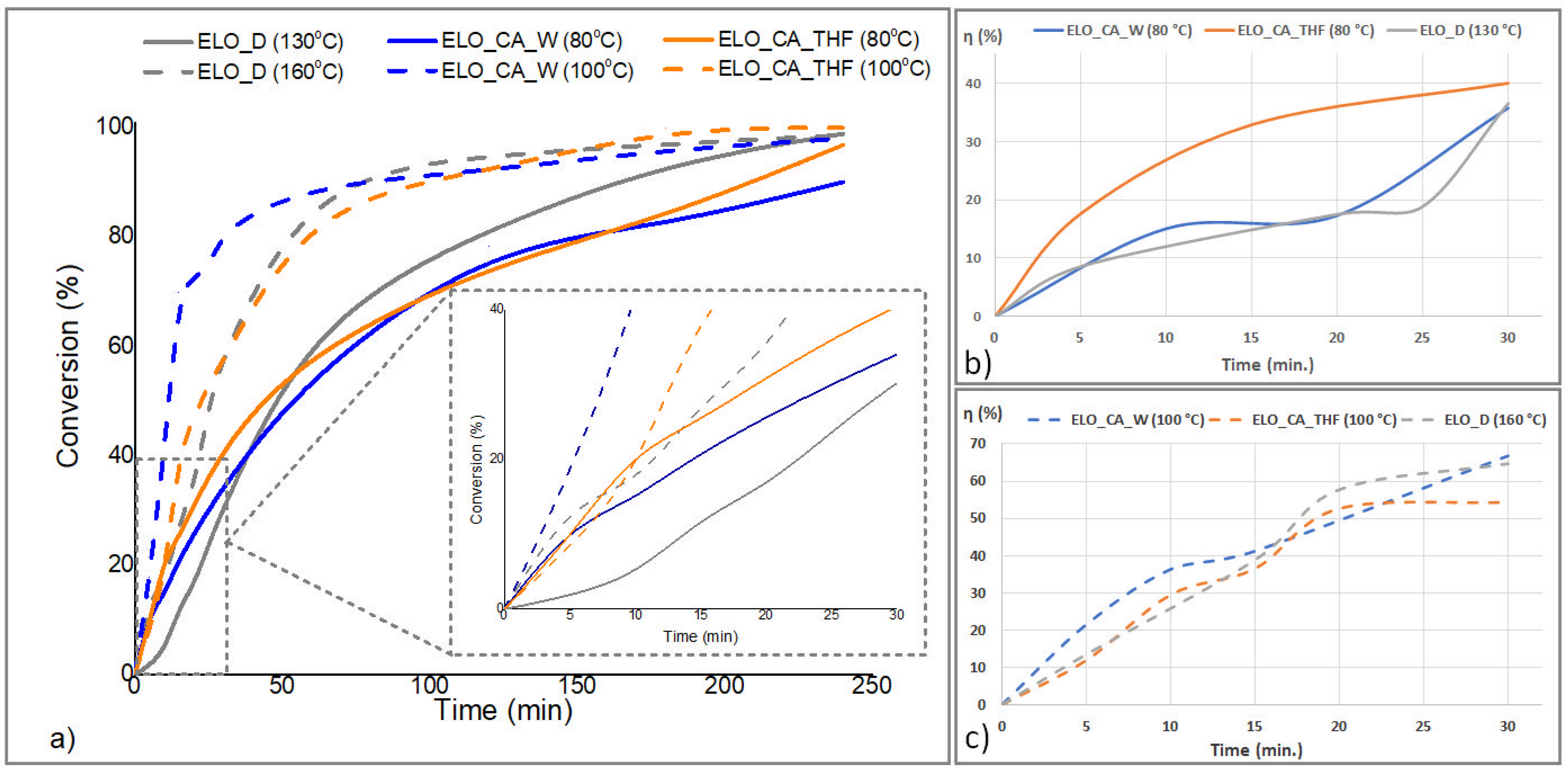
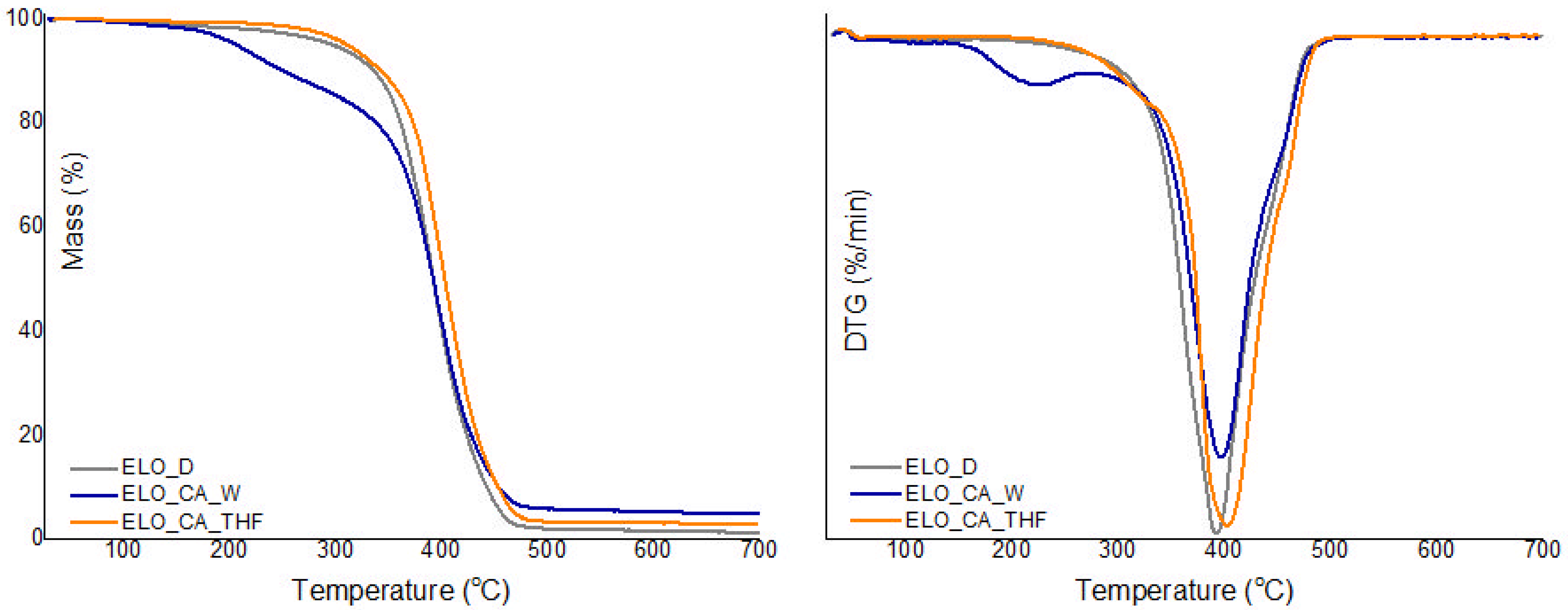
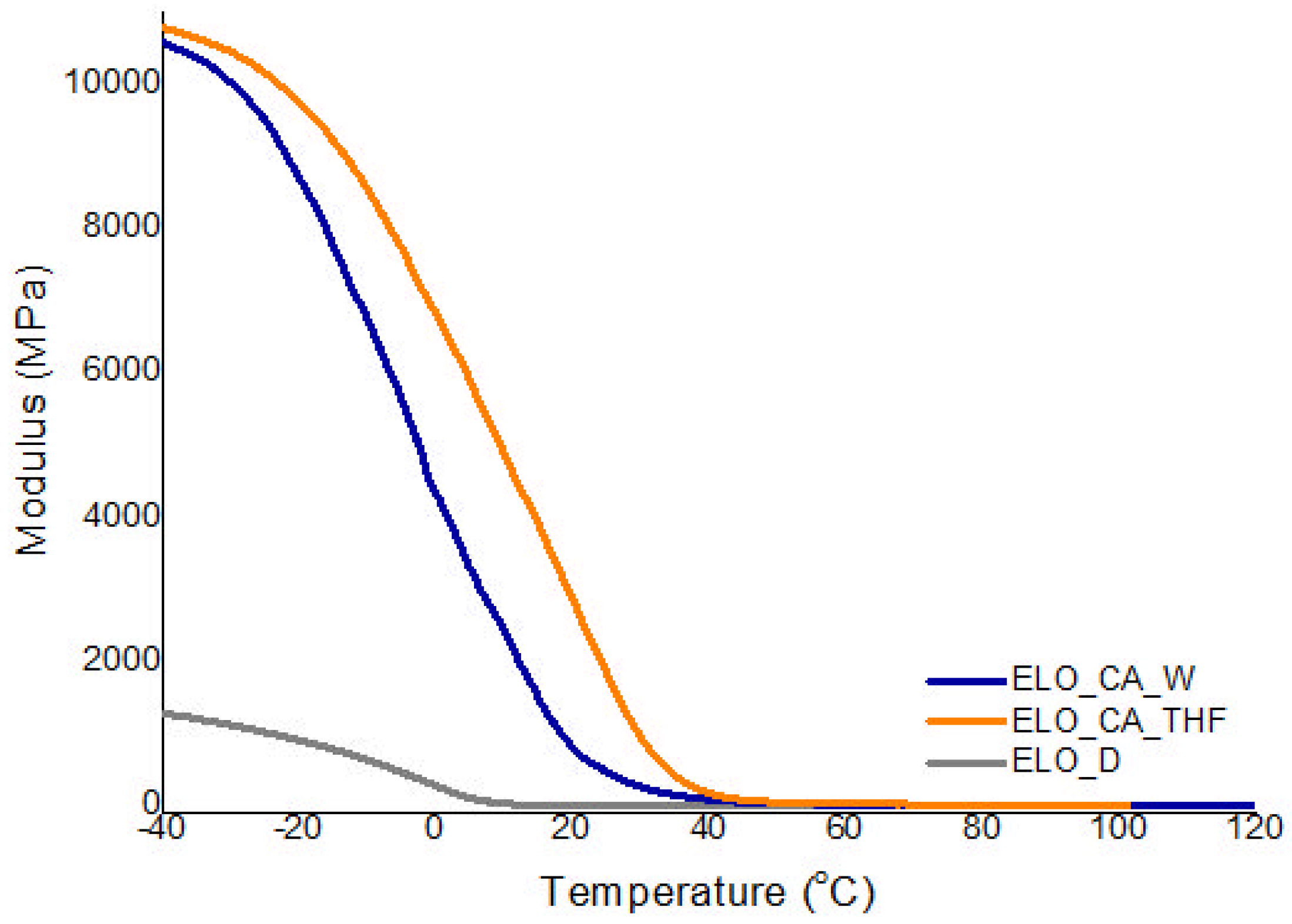
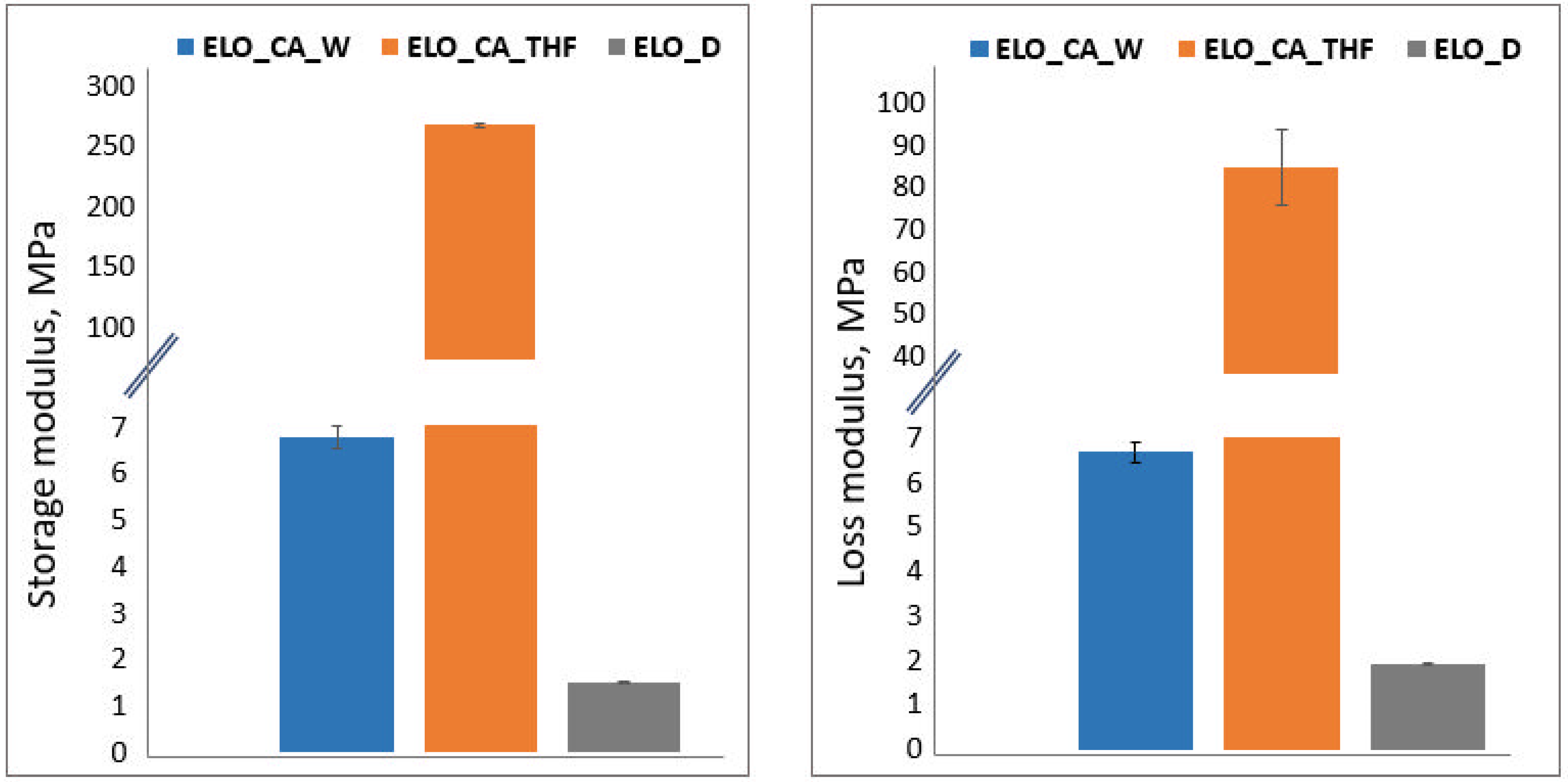


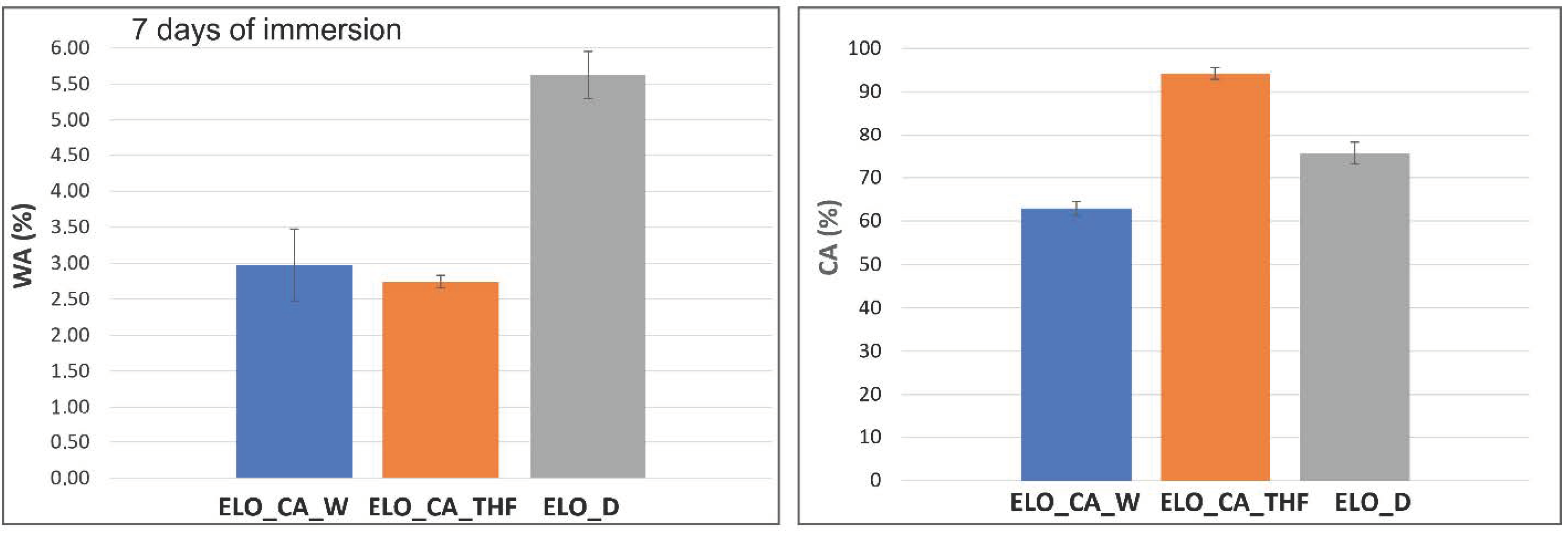
| Polymer Matrix | |||||
|---|---|---|---|---|---|
| System Code | Components | Curing Temperatures | |||
| ELO | CA | D230 | |||
| H2O | THF | ||||
| ELO_CA_W | x | x | - | - | 80 °C, 3 h 120 °C, 1 h 150 °C, 1 h |
| ELO_CA_THF | x | - | x | - | 80 °C, 3 h 120 °C, 1 h 150 °C, 1 h |
| ELO_D | x | - | - | x | 130 °C, 2 h 160 °C, 3 h |
| Sample | ∆H a (J/g) | Tp b (°C) | Ea c (KJ/mol) |
|---|---|---|---|
| ELO_CA_W | 125.5 | 100.4 | 39.27 |
| ELO_CA_THF | 174.1 | 108.0 | 69.84 |
| ELO_D | 170.7 | 218.4 | 20.04 |
| Sample | TGA | DMA | ||||
|---|---|---|---|---|---|---|
| Td5% a (°C) | Td10% b (°C) | Residual Mass (%, at 700 °C) | Tmax (°C) | Tg c (°C) | Crosslink Density (mol/ m3) | |
| ELO_CA_W | 206.9 | 250.7 | 4.94 | 395.8 | 39 | 1414 |
| ELO_CA_THF | 311.4 | 343.0 | 3.07 | 402.4 | 41 | 2477 |
| ELO_D | 298.2 | 336.2 | 1.36 | 394.5 | 29 | 417 |
| Sample | θ (°, water) | θ (°, EG) a | Surface Free Energy (Nm/m) |
|---|---|---|---|
| ELO_CA_W | 62.89 ± 1.65 | 52.37 ± 2.54 | 41.50 |
| ELO_CA_THF | 94.25 ± 1.36 | 67.49 ± 1.53 | 29.50 |
| ELO_D | 75.65 ± 2.45 | 61.73 ± 2.48 | 28.39 |
Publisher’s Note: MDPI stays neutral with regard to jurisdictional claims in published maps and institutional affiliations. |
© 2022 by the authors. Licensee MDPI, Basel, Switzerland. This article is an open access article distributed under the terms and conditions of the Creative Commons Attribution (CC BY) license (https://creativecommons.org/licenses/by/4.0/).
Share and Cite
Necolau, M.I.; Damian, C.M.; Olaret, E.; Iovu, H.; Balanuca, B. Comparative Thermo-Mechanical Properties of Sustainable Epoxy Polymer Networks Derived from Linseed Oil. Polymers 2022, 14, 4212. https://doi.org/10.3390/polym14194212
Necolau MI, Damian CM, Olaret E, Iovu H, Balanuca B. Comparative Thermo-Mechanical Properties of Sustainable Epoxy Polymer Networks Derived from Linseed Oil. Polymers. 2022; 14(19):4212. https://doi.org/10.3390/polym14194212
Chicago/Turabian StyleNecolau, Madalina Ioana, Celina Maria Damian, Elena Olaret, Horia Iovu, and Brindusa Balanuca. 2022. "Comparative Thermo-Mechanical Properties of Sustainable Epoxy Polymer Networks Derived from Linseed Oil" Polymers 14, no. 19: 4212. https://doi.org/10.3390/polym14194212
APA StyleNecolau, M. I., Damian, C. M., Olaret, E., Iovu, H., & Balanuca, B. (2022). Comparative Thermo-Mechanical Properties of Sustainable Epoxy Polymer Networks Derived from Linseed Oil. Polymers, 14(19), 4212. https://doi.org/10.3390/polym14194212









